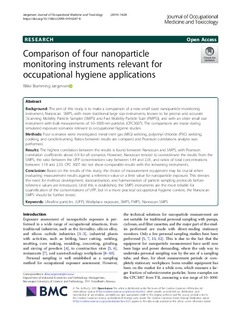| dc.contributor.author | Jørgensen, Rikke Bramming | |
| dc.date.accessioned | 2020-01-13T10:06:49Z | |
| dc.date.available | 2020-01-13T10:06:49Z | |
| dc.date.created | 2020-01-07T15:21:48Z | |
| dc.date.issued | 2019 | |
| dc.identifier.citation | Journal of Occupational Medicine and Toxicology. 2019, 14 28-?. | nb_NO |
| dc.identifier.issn | 1745-6673 | |
| dc.identifier.uri | http://hdl.handle.net/11250/2635897 | |
| dc.description.abstract | Background
The aim of this study is to make a comparison of a new small sized nanoparticle monitoring instrument, Nanoscan SMPS, with more traditional large size instruments, known to be precise and accurate [Scanning Mobility Particle Sampler (SMPS) and Fast Mobility Particle Sizer (FMPS)], and with an older small size instrument with bulk measurements of 10–1000 nm particles (CPC3007). The comparisons are made during simulated exposure scenarios relevant to occupational hygiene studies.
Methods
Four scenarios were investigated: metal inert gas (MIG) welding, polyvinyl chloride (PVC) welding, cooking, and candle-burning. Ratios between results are compaed and Pearsson correlations analysis was performed.
Results
The highest correlation between the results is found between Nanoscan and SMPS, with Pearsson correlation coefficients above 0.9 for all scenarios. However, Nanoscan tended to overestimate the results from the SMPS; the ratio between the UFP concentrations vary between 1.44 and 2.01, and ratios of total concentrations between 1.18 and 2.33. CPC 3007 did not show comparable results with the remaining instruments.
Conclusion
Based on the results of this study, the choice of measurement equipment may be crucial when evaluating measurement results against a reference value or a limit value for nanoparticle exposure. This stresses the need for method development, standardisation, and harmonisation of particle sampling protocols before reference values are introduced. Until this is established, the SMPS instruments are the most reliable for quantification of the concentrations of UFP, but in a more practical occupational hygiene context, the Nanoscan SMPS should be further tested. | nb_NO |
| dc.language.iso | eng | nb_NO |
| dc.publisher | BMC (part of Springer Nature) | nb_NO |
| dc.relation.uri | https://occup-med.biomedcentral.com/track/pdf/10.1186/s12995-019-0247-8 | |
| dc.rights | Navngivelse 4.0 Internasjonal | * |
| dc.rights.uri | http://creativecommons.org/licenses/by/4.0/deed.no | * |
| dc.title | Comparison of four nanoparticle monitoring instruments relevant for occupational hygiene applications | nb_NO |
| dc.type | Journal article | nb_NO |
| dc.type | Peer reviewed | nb_NO |
| dc.description.version | publishedVersion | nb_NO |
| dc.source.pagenumber | 28-? | nb_NO |
| dc.source.volume | 14 | nb_NO |
| dc.source.journal | Journal of Occupational Medicine and Toxicology | nb_NO |
| dc.identifier.doi | 10.1186/s12995-019-0247-8 | |
| dc.identifier.cristin | 1767877 | |
| dc.description.localcode | © The Author(s). 2019 Open Access This article is distributed under the terms of the Creative Commons Attribution 4.0 International License (http://creativecommons.org/licenses/by/4.0/) | nb_NO |
| cristin.unitcode | 194,60,25,0 | |
| cristin.unitname | Institutt for industriell økonomi og teknologiledelse | |
| cristin.ispublished | true | |
| cristin.fulltext | original | |
| cristin.qualitycode | 1 | |

